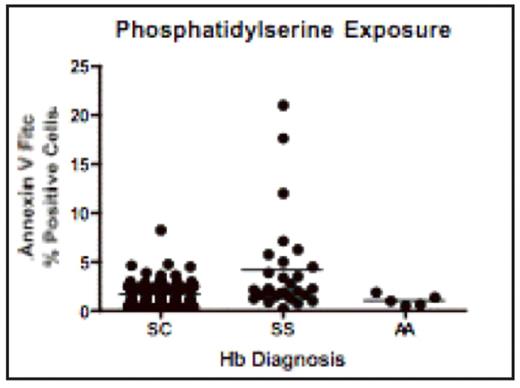Abstract
Red blood cells (RBCs) in sickle cell anemia are characterized by increased adhesion to laminin and endothelial cells, due both to increased adhesion receptor expression as well as receptor activation. However, these RBC properties have not been comprehensively evaluated in HbSC disease. In the on-going multi-center CHAMPS trial, all subjects have a diagnosis of HbSC disease and have had at least one significant vaso-occlusive event in the previous 12 months (but none in the previous 4 weeks). All subjects are at least 5 years of age (median 13.4 yr, range = 5.2–53.3 yr) at enrollment. Subjects receive hydroxyurea (HU) and/or magnesium pidolate (Mg) (or their placebos); endpoints include the effect of study drugs on erythrocyte density and RBC-endothelial interactions. To characterize the adhesive properties of RBCs at baseline in these patients, we performed the following analyses on blood samples shipped to a central lab at Duke University from 11 participating sites: adhesion to laminin at 1 dyne/cm2 shear stress; adhesion to endothelial cells after epinephrine (epi) stimulation of RBCs at shear stress of 1 dyne/cm2; and phosphatidylserine exposure, as measured by mean fluorescence intensity after binding of fluoresceinated annexin V. Most subjects had two pre-treatment specimens analyzed. Analysis of the first 83 samples (47 patients) showed that a mean of 1.64% (± 0.15% SEM) of circulating HbSC RBCs expressed phosphatidylserine, or a little less than half as many as in HbSS RBC samples (4.12% positive ± .91% SEM, n = 29) tested as controls (HbSC vs HbSS p=.0009). However HbSC RBCs were also different from HbAA RBCs (1.076% positive, n = 5), and all three sets of values were significantly different by ANOVA (p = .0017) (Figure). The two baseline visits for HbSC subjects resulted in nearly identical means of 1.64% and 1.65%, respectively. Adhesion of HbSC red cells to laminin at baseline was quite variable among patients, with a mean of 36.1 adherent cells/mm2 (range 2–256). This was slightly but not significantly lower than the values obtained using HbSS control RBCs (mean 58.8 cells/mm2, range 0.2–258). After epi stimulation of RBCs, 9.6% of cells adhered to endothelial monolayers at 1 dyne/cm2, whereas 14.8% of HbSS RBCs were adherent (p = .186). HbAA RBCs showed minimal adhesion in both assays (< 5 cells/mm2 and <3%, respectively). Finally, no correlation was found by linear regression analysis between phosphatidylserine exposure and either adhesion to laminin or adhesion to endothelial cells. In summary, HbSC RBCs show appreciable adhesion to both laminin and endothelial cells, as well as phosphatidylserine exposure. While in general these abnormalities are less pronounced than for HbSS RBCs, they are still well outside the normal range and provide potential targets for therapeutic intervention.
Disclosures: No relevant conflicts of interest to declare.
Author notes
Corresponding author


This feature is available to Subscribers Only
Sign In or Create an Account Close Modal